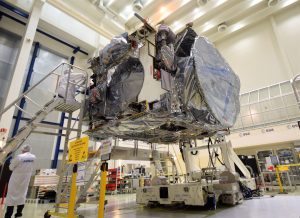
Located in Noordwijk – in the European Space Research and Technology Centre (ESTEC) – LSS is described as Europe’s single largest vacuum chamber. It’s a cylindrical container, standing 15m high and 10m wide and the simulator is used to test full-size spacecraft in representative space conditions.
As the acronym suggests, Juice will study both Jupiter and its three large ocean-bearing moons. It first moved to ESTEC in April.
The European agency writes:
“Once the door of the Large Space Simulator (LSS) is sealed, Juice will spend several weeks being subjected to extreme heating and cooling cycles under vacuum, to confirm the spacecraft is ready for its long journey through the Solar System to Jupiter. Juice will experience highs of 250ºC close to Venus, and lows of around -180ºC in the Jovian system.
Since arriving at ESA’s European Space Research and Technology Centre (ESTEC) in April, a number of activities have taken place ahead of the environmental testing. This included the application of multi-layered insulation, a deployment test of the medium-gain antenna, and other preparatory activities.”
According to ESA, the Simulator’s high-performance pumps can achieve a vacuum a billion times lower than standard sea level atmosphere, while liquid nitrogen circulated around the Simulator approximates the cryogenic temperatures of space.
“An array of powerful xenon lamps can reproduce the unfiltered sunlight encountered in Earth orbit, or turned up even higher to duplicate the energy intensity experienced closer to the Sun. Hardware can also be rotated in order to reproduce characteristic orbital motion as testing proceeds.”
Pictured below is a deployment test of the medium-gain antenna.
Juice will remain at ESTEC until July, before being transported to Toulouse for its final round of tests. From there it will travel to Europe’s Spaceport in French Guiana, to be launched on an Ariane 5 rocket next year, says ESA. It is expected to arrive near Jupiter in 2029.
Large Space Simulator
With an overall volume of 2300 cubic metres, the LSS consists of the main chamber, with a stable specimen-support platform, mechanically decoupled from both chamber and building movements providing a very quiet mechanical environment. This is very important for dynamic tests, optical calibration and heat-pipe operations during heat balance phases, says ESA.
There is also an auxiliary chamber (a horizontal cylinder that provides a stable interface with the solar simulation optics and houses the lens producing the parallel beam on a rigid support structure), a number of stainless steel shrouds (which are temperature controlled, using liquid or gaseous nitrogen, in a range from 353 down to 100 Kelvin depending on the operational mode selected), a Sun simulator subsystem (providing a horizontal solar beam of 6-m diameter) a high-vacuum subsystem (a typical vacuum level of one-millionth of a millibar is achieved using turbo-molecular pumps and two closed-cycle refrigerator cryopumps) and a motion simulator (for placing test articles in almost any position relative to the solar radiation axis).
All the facility parameters are recorded and available in real time for the operators to monitor the test. A dedicated data handling computer collects data for analysis and for detailed fault finding in case of failure.
By Jove
Juice will make detailed observations of Jupiter and its three large ocean-bearing moons – Ganymede, Callisto and Europa – with a suite of remote sensing, geophysical and in situ instruments.
The mission is intended to investigate the emergence of habitable worlds around gas giants and the Jupiter system to help learn about other, numerous giant exoplanets now known to orbit other stars.